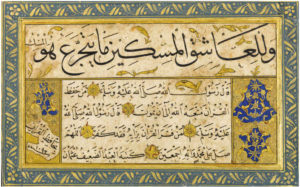The Naskh Script
By: F.K. Art Intern Nimah Bhura
Have you ever wondered what script the Quran is written in? The Quran’s main purpose is to deliver a message, and in order to do that it must be legible. Therefore, calligraphers most commonly use a script called Naskh when writing the Quran. Naskh is, in many opinions, the easiest script to read, making it a great candidate when choosing a Quranic script.
Naskh literally means “to copy”, which describes the ease and agility in which a calligrapher is able to copy the script. When writing the entire Quran, it is preferable to use a more simplistic text than a more complex one. The script is thought to have been invented by the calligrapher, Ibn Muqlah Shirazi, and replaced the Kufic script. The Naskh script’s legibility is the main reason for its popularity.
Other scripts were also based on the Naskh script. One of them being Nastaliq, a hybrid of the Naskh and Taliq scripts. Nastaliq was originally used in Persia, and eventually in India and Pakistan. It was used to write literature and poetry, instead of Quranic verses. It is one of the most difficult scripts to master, and looks as though the letters are hanging or floating on the page. Every script in Arabic calligraphy is connected because in all of them there are attributes of one another.
Author’s Bio: I am a High School student just trying to learn more about art. I own 5 galleries and over 100 pieces of my work are featured all over the world— I wish. I am just trying to communicate a message to anyone who will listen, even if that is just my parents.
